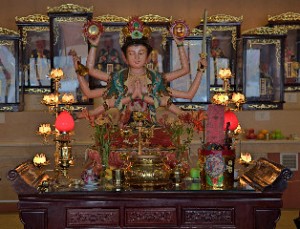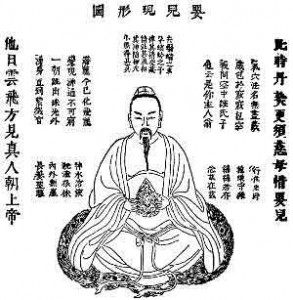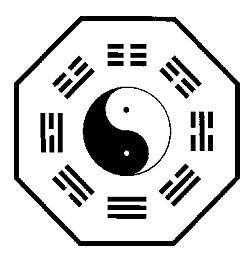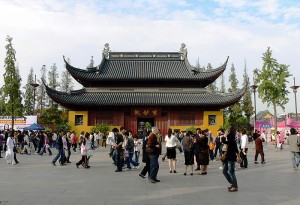TAOISM – Taoist Tai Chi Society™
Taoism (or Daoism) refers to a variety of related philosophical and religious traditions that have influenced Eastern Asia for more than two millennia, and have had a notable influence on the western world particularly since the 19th century. The word 道, Tao (or Dao, depending on the romanization scheme), literally translates as, „path“ or „way“ (of life), although in Chinese folk religion and philosophy it carries more abstract meanings. Taoist propriety and ethics emphasize the Three Jewels of the Tao: compassion, moderation, and humility, while Taoist thought generally focuses on nature, the relationship between humanity and the cosmos (天ä��相应), health and longevity, and wu wei (action through inaction), which is thought to produce harmony with the Universe. Read More: > HERE <
Tao (pronounced „Dow“) can be roughly translated into English as path, or the way. It is basically indefinable. It has to be experienced. It „refers to a power which envelops, surrounds and flows through all things, living and non-living. The Tao regulates natural processes and nourishes balance in the Universe. It embodies the harmony of opposites (i.e. there would be no love without hate, no light without dark, no male without female.)“
The founder of Taoism is believed by many religious historians to be Lao-Tse (604-531 BCE), whose life overlapped that of Confucius (551-479 BCE). (Alternative spellings: Lao Tze, Lao Tsu, Lao Tzu, Laozi, Laotze, etc.). However other historians suggest that he is a synthesis of a number of historical figures. Others suggest that he was a mythical figure. Still others suggest that he lived in the 4th century BCE.
He was searching for a way that would avoid the constant feudal warfare and other conflicts that disrupted society during his lifetime. The result was his book: Tao-te-Ching (a.k.a. Daodejing). Others believe that he is a mythical character.
A Taoist priest (Sai Kong) chanting the scripture in Hokkien for the Nine Emperor Gods Festival in Tao Bo Keong, Penang.
Taoism started as a combination of psychology and philosophy but evolved into a religious faith in 440 CE when it was adopted as a state religion. At that time Lao-Tse became popularly venerated as a deity. Taoism, along with Buddhism and Confucianism, became one of the three great religions of China. With the end of the Ch’ing Dynasty in 1911, state support for Taoism ended. Much of the Taoist heritage was destroyed during the next period of warlordism. After the Communist victory in 1949, religious freedom was severely restricted. „The new government put monks to manual labor, confiscated temples, and plundered treasures. Several million monks were reduced to fewer than 50,000“ by 1960. 3 During the cultural revolution in China from 1966 to 1976, much of the remaining Taoist heritage was destroyed. Some religious tolerance has been restored under Deng Xiao-ping from 1982 to the present time.
Taoism currently has about 20 million followers, and is primarily centered in Taiwan. About 30,000 Taoists live in North America; 1,720 in Canada (1991 census).
Taoism has had a significant impact on North American culture in areas of „acupuncture, herbalism, holistic medicine, meditation and martial arts…
The Yin Yang symbol: This is a well known Taoist symbol. „It represents the balance of opposites in the universe. When they are equally present, all is calm. When one is outweighed by the other, there is confusion and disarray.“ One source explains that it was derived from astronomical observations which recorded the shadow of the sun throughout a full year. The two swirling shapes inside the symbol give the impression of change — the only constant factor in the universe. One tradition states that Yin (the dark side) represents the breath that formed the earth. Yang (the light side) symbolizes the breath that formed the heavens.
One source states: „The most traditional view is that ‚yin‘ represents aspects of the feminine: being soft, cool, calm, introspective, and healing… and „yang“ the masculine: being hard, hot, energetic, moving, and sometimes aggressive. Another view has the ‚yin‘ representing night and ‚yang‘ day.
Another source offers a different definition: A common misconception in the west is that „…yin is soft and passive and yang is hard and energetic. Really it is yang that is soft and yin that is hard, this is because yang is energetic and yin is passive. Yin is like a rock and yang is like water or air, rock is heavy and hard and air is soft and energetic.“
Allan Watts, describes the yin and yang as negative and positive energy poles: „The ideograms indicate the sunny and shady sides of a hill….They are associated with the masculine and the feminine, the firm and the yielding, the strong and the weak, the light and the dark, the rising and the falling, heaven and earth, and they are even recognized in such everyday matters as cooking as the spicy and the bland.“
However, since nothing in nature is purely black or purely white, the symbol includes a small black spot in the white swirl, and a corresponding white spot in the black swirl.
Ultimately, the ‚yin‘ and ‚yang‘ can symbolize any two polarized forces in nature. Taosts believe that humans often intervene in nature and upset the balance of Yin and Yang. Full Article: http://www.religioustolerance.org
- www.wudanggongfu.com
- Dein Ayurveda Net:…. Articles on TCM <
- WU XING, 5 Elements, Roots of Chinese Medicine <
- Meet Wudang Conception, studies, friends at fb <
- Meet International Taoist Tai Chi Society, friends and studies at fb <
- Meet Traditional Chinese Medicine, studies, friends and fans at fb <
- Meet Lao Tzu, studies, friends, fans at fb <
- Council for a Parliament of the World’s Religions (CPWR) <




Comments are closed.
